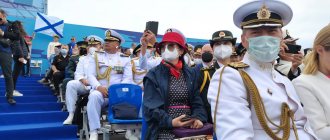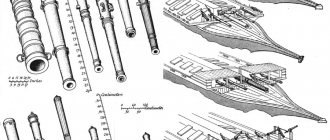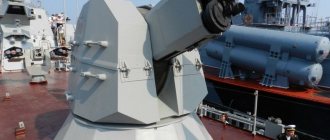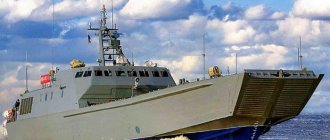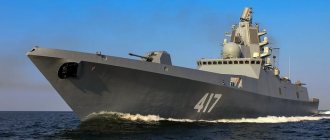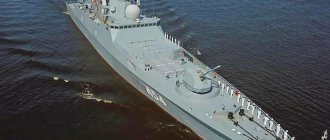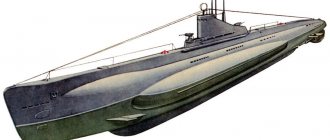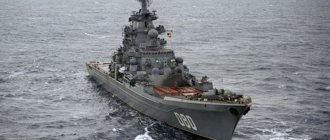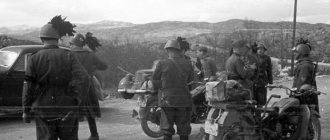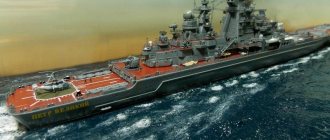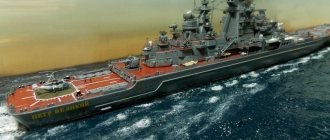Three centuries of glory
The official date of the emergence of the Russian Imperial Navy is considered to be October 20, 1696. On this day, Tsar Peter I issued a decree to begin the construction of galleys that would protect the newly conquered fortress of Azov from Turkish troops. For the construction of wooden ships, a shipyard was built in the city of Voronezh.
Northern War 1700-1721 and the construction of a port city on the Neva (1703) laid the foundation for the sailing fleet in the Baltic. In 1718, the highest executive body, the Admiralty Board, was created to manage the affairs of the navy. The fleet of Peter I included wooden ships of various classes:
- Battleships;
- Frigates;
- Galleys;
- Shnyavy.
The number of cannon weapons on them amounted to tens of units. The most powerful were the battleships, from both sides of which up to a hundred smooth-bore guns, firing red-hot cannonballs, looked menacingly at the enemy.
The Admiralty Board was located here Source: Wikipedia.org
In the glorious history of the Russian fleet there are dozens of battles where sailors showed their valor and courage. Over 300 years, the Russians won 75 fights involving ships made of wood or metal, with smoothbore/rifled guns. Among the most famous are the battles of Chesma, Sinop, Trebizond, Navarino, Gangut, and Grengam.
The modern history of the fleet is usually counted from the second third of the 19th century - the moment of the appearance of steam propulsion in shipbuilding and the beginning of the use of steel for the manufacture of ship hull parts. Today, the Russian fleet, which has become the heir to the naval history of the USSR, has five associations - the Northern, Pacific, Baltic, Black Sea fleets and the Caspian flotilla.
20th century in the history of the Russian fleet
The 20th century became the most dramatic in the history of the Russian fleet. He had to go through 3 revolutions, the active participants of which were the lower ranks of the ship's crews, two world wars, as a result of which up to 90% of the old fleet was destroyed. Having experienced a period of unprecedented prosperity - by 1985, the USSR Navy ranked 2nd in the world in terms of the number of ships (1561 ships), and a period of complete collapse. By 2010, less than 10% of the previous number of ships (136 units) remained in the fleet. In the Black Sea, the Russian fleet is 4.7 times inferior in number of ships to the Turkish fleet, and in the European direction it is more than 20 times weaker than the combined NATO fleet.
According to Admiral Kasatonov: “the list of tasks that the Russian fleets have and can carry out today is actually limited to coastal protection and anti-terrorism activities. But all this is at the level of territorial waters.” Failed economic policies have turned the once mighty navy, a global power, into a coastal fleet of small vessels capable of operating only in coastal waters. The few large ships that survived the collapse of the USSR are morally and physically outdated and are of more museum value than military strength, despite constant modernization.
List of ships of the Russian Navy
Today, the Russian Navy includes modern submarine and surface vessels for various purposes. Depending on the volume of combat, training and special missions performed, they are distributed across all operational-strategic formations. The total number of ships is 294, including (submarines + surface ships):
- Baltic Sea FleetBaltic Fleet – 54 (1+53);
- Black Sea Fleet – 54 (7+47);
- Northern Fleet – 83 (42+41);
- Pacific Fleet - 76 (21+55);
- Caspian Flotilla – 27 (0+27).
In addition to, in fact, sea-based military equipment, the naval forces include the marine corps, air defense aviation, coastal defense and logistics forces. They are distributed in places of permanent deployment. In the navy they are called base points.
The headquarters of the Northern Fleet is located in Severomorsk, the permanent bases of the fleet are in Gremikha, Gadzhievo, Vidyaevo, Zaozersk, Polyarny, Olenya Guba and Severodvinsk. The main city of the Pacific Fleet is Vladivostok. The fleet's warships are located in the Danube, Sovetskaya Gavan, Fokin (Primorsky Territory), Vilyuchinsk (Kamchatka Territory).
Composition and equipment of the fleet
Like the other two branches of the Armed Forces of the Russian Federation, the fleet is equipped with a large amount of modern equipment and weapons. The structure of the Navy is submarine and surface forces, naval aviation, coastal defense troops and marines, and logistics support units. Each structural unit has clear tasks, the solution of which is daily military service for the benefit of the Motherland.
Submarine forces
The basis of the submarine fleet of the Russian Federation consists of two types of vessels:
- With a nuclear power plant;
- With diesel-electric power plant.
Nuclear submarinesNuclear submarines are based in two operational-strategic formations - the Northern and Pacific fleets.
The modern fleet of nuclear submarines consists of third/fourth generation ships with ballistic/cruise missiles. Based on the range of combat missions they perform, boats are divided into three categories: strategic, multi-purpose, and special purpose. The main task is reconnaissance, covert observation of the actions of a potential enemy, and surprise strikes against targets on land/sea.
Project 971 submarine “Pike-B” Source: Wikipedia.org
The fleet of nuclear submarines of the Russian Navy is 39 units. They are distributed among their bases in the Northern and Pacific fleets. Another 8 submarines with nuclear reactors perform special tasks and scientific research. There is one boat of this type in the diesel-electric submarine fleet. The remaining 23 are in combat service in four fleets.
Surface forces
The tasks of Navy surface ships include the protection of sea and coastal communications, landing operations, laying minefields, anti-submarine reconnaissance, performing combat deployment missions and escorting submarine forces. This is the largest fleet of ships. It consists of ships of several types:
- Cruisers;
- Frigates;
- Corvettes;
- Anti-submarine ships;
- Landing ships;
- Missile and artillery boats;
- Watchmen;
- Minesweepers;
- Patrol vessels.
The surface forces include the only heavy aircraft carrier of Russia and the USSR, the aircraft-carrying cruiser of Project 1143.3 “Admiral of the Fleet of the Soviet Union Kuznetsov”. The flagships of the fleets are heavy nuclear-powered missile cruisers of Project 1144 (Peter the Great, Northern Fleet) and 1164 (Varyag, Pacific Fleet). 223 vessels are distributed among the fleets as follows: Baltic Fleet - 53, Black Sea Fleet - 47, Northern Fleet - 41, Pacific Fleet - 55, Kaliningrad Fleet - 27.
Naval aviation
Aviation units of the Navy Aviation of the Russian Navy, including aircraft of the TAKR air group of Project 1143.3, are located at coastal bases. Their tasks include searching for and timely detection of enemy submarines, striking sea and coastal communications, targeting units of the military space forces, and repelling attacks from enemy aircraft and missiles.
Typical composition of naval aviation:
- Deck;
- Beregovaya;
- Unmanned aerial vehicles (UAVs).
Species composition:
- Carrier-based fighters Su-33, MiG-29K/KUB;
- Front-line fighters Su-30, Su-30MK, Su-35;
- Su-25UTG training aircraft;
- Long-range anti-submarine aircraft Tu-142;
- Tactical anti-submarine aircraft - Il-20, Il-38, Il-38N;
- MiG-31 interceptors;
- Anti-submarine helicopters Ka-27, Ka-27M, Ka-29, Ka-31.
The locations of strategic and tactical naval aviation are areas close to the bases of the forces of the potential enemy’s fleets and military infrastructure facilities.
Coastal Defense Forces and Marines
It is not difficult to guess from the name that the coastal defense forces are responsible for protecting the bases of the main forces of the navy at operational-strategic formations from reconnaissance activities and direct attacks by the enemy. They are based on air defense troops equipped with powerful modern missile weapons. The main task is to protect the coastline and border area, preventing the landing of enemy forces from the sea and air.
It may be interesting: Russian Battle Fleet
The Marines are the naval first strike force and special forces. They perform the same tasks as airborne troops as part of the Ground Forces of the Russian Armed Forces. Marine forces are capable of delivering lightning strikes on enemy communications, clearing the way for the main forces to attack. To do this, they are equipped with floating equipment and operate with the support of naval aviation. The landing of marine forces ashore is carried out using landing craft.
Rear units and units
The functioning of all combat units of the navy is impossible without logistics support forces. They are called upon to carry out the tasks of uninterrupted supply of naval units with food, supplies, materials, fuel, clothing and cash allowances, and medical support for military personnel. Carry out fire and rescue operations, evacuation of the wounded. Sick and injured people in emergency situations.
Banner of the Navy of the Russian Federation Source: Wikipedia.org
The level of combat readiness of the Russian Navy depends on the degree of clarity of interaction between rear units and operational formations. The operational-strategic unit is part of the logistics support of the Armed Forces.
Where are naval officers trained?
From the very first years of its existence, great importance was given to the training of officers for the navy. The first officers were trained abroad, in Holland and France, then in navigation schools. The first Russian higher naval educational institution was the Naval Guard Academy, opened in St. Petersburg in 1715. Subsequently, future naval officers received a multi-stage higher education; initially, the children of nobles and commoners studied in naval cadet corps. Having received the rank of midshipman, they could continue to serve in the navy or study at naval schools, officer classes and schools.
The modern system of naval education has undergone significant changes. A sharp reduction in the size of the fleet led to a reduction in educational institutions. As of 01/01/2020, specialists of various profiles are being trained for the Russian Navy:
- Baltic Naval Institute (formerly F.F. Ushakov Baltic Higher Naval School);
- Military Medical Academy named after. CM. Kirov (maritime faculty);
- Naval Engineering Institute (formerly V.I. Lenin Higher Naval Engineering School);
- Naval Institute of Radio Electronics (formerly Higher Naval School of Radio Electronics named after A.S. Popov);
- Military University of the Ministry of Defense of the Russian Federation (Naval Faculty);
- Red Banner Training Division of Scuba Diving named after S.M. Kirov;
- Marine Corps of Peter the Great - St. Petersburg Naval Institute (formerly the Higher Naval School named after M.V. Frunze);
- Pacific Naval Institute named after. S.O. Makarov (formerly Pacific Higher Naval School named after S.O. Makarov).
Banner of the Navy of the Russian Federation
The main symbol for sailors is the ship's flag. The tradition of raising and lowering it is a mandatory daily military ritual. From the first days of the fleet's history to the present day, the color scheme has remained virtually unchanged. The banner always featured two or three colors, including:
- White;
- Red;
- Blue.
For the first time, a white and blue ship's flag flew on the mast of the ship "Eagle", which took part in the battle with the Turks for Azov (1696). After the establishment of the main naval award, the Order of St. Andrew the First-Called (1699), the naval military banner received the name St. Andrew's flag. 218 years later, on December 26, 1917, it was replaced by the naval flag of the RSFSR (from 1922 - USSR), and existed until the collapse of the Soviet Union.
The date of the revival of traditions and rituals associated with the St. Andrew's flag is July 26, 1992. Six months after the formation of the Russian Federation, the main symbol of the fleet again took its rightful place. It is a white cloth with diagonal stripes crossed in the center. Flag dimensions:
- Width – 1/10 length;
- The ratio of width to length is 2/3.
In addition to the banner, the banner includes a pole with a pommel, bracket, and inflow. The naval flag of the Russian Federation has undergone only one change in 29 years: on January 1, 2001, the blue color of the stripes was replaced with the original blue. For celebrations/rituals, two more versions of the naval banner are used - the Guards (with the St. George ribbon), the Order (with the image of the Order of St. Andrew the First-Called).
